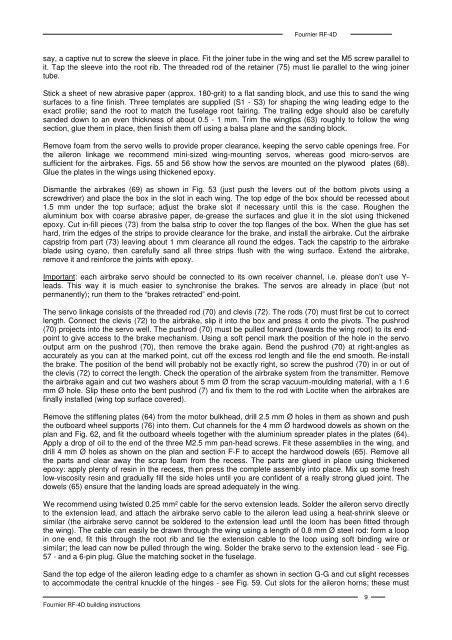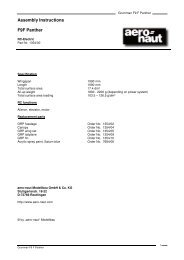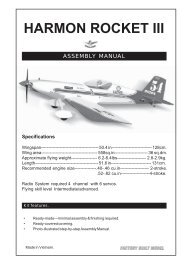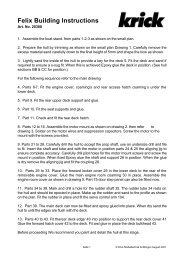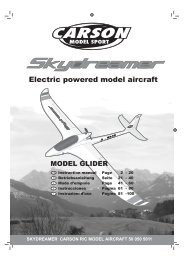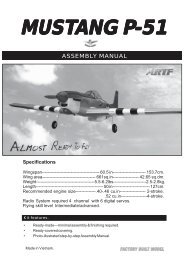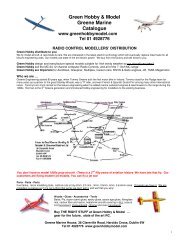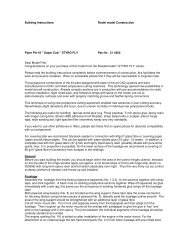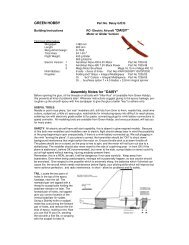Building instructions Fournier RF-4D - Aero-naut
Building instructions Fournier RF-4D - Aero-naut
Building instructions Fournier RF-4D - Aero-naut
Create successful ePaper yourself
Turn your PDF publications into a flip-book with our unique Google optimized e-Paper software.
<strong>Fournier</strong> <strong>RF</strong>-<strong>4D</strong>say, a captive nut to screw the sleeve in place. Fit the joiner tube in the wing and set the M5 screw parallel toit. Tap the sleeve into the root rib. The threaded rod of the retainer (75) must lie parallel to the wing joinertube.Stick a sheet of new abrasive paper (approx. 180-grit) to a flat sanding block, and use this to sand the wingsurfaces to a fine finish. Three templates are supplied (S1 - S3) for shaping the wing leading edge to theexact profile; sand the root to match the fuselage root fairing. The trailing edge should also be carefullysanded down to an even thickness of about 0.5 - 1 mm. Trim the wingtips (63) roughly to follow the wingsection, glue them in place, then finish them off using a balsa plane and the sanding block.Remove foam from the servo wells to provide proper clearance, keeping the servo cable openings free. Forthe aileron linkage we recommend mini-sized wing-mounting servos, whereas good micro-servos aresufficient for the airbrakes. Figs. 55 and 56 show how the servos are mounted on the plywood plates (68).Glue the plates in the wings using thickened epoxy.Dismantle the airbrakes (69) as shown in Fig. 53 (just push the levers out of the bottom pivots using ascrewdriver) and place the box in the slot in each wing. The top edge of the box should be recessed about1.5 mm under the top surface; adjust the brake slot if necessary until this is the case. Roughen thealuminium box with coarse abrasive paper, de-grease the surfaces and glue it in the slot using thickenedepoxy. Cut in-fill pieces (73) from the balsa strip to cover the top flanges of the box. When the glue has sethard, trim the edges of the strips to provide clearance for the brake, and install the airbrake. Cut the airbrakecapstrip from part (73) leaving about 1 mm clearance all round the edges. Tack the capstrip to the airbrakeblade using cyano, then carefully sand all three strips flush with the wing surface. Extend the airbrake,remove it and reinforce the joints with epoxy.Important: each airbrake servo should be connected to its own receiver channel, i.e. please don’t use Y-leads. This way it is much easier to synchronise the brakes. The servos are already in place (but notpermanently); run them to the “brakes retracted” end-point.The servo linkage consists of the threaded rod (70) and clevis (72). The rods (70) must first be cut to correctlength. Connect the clevis (72) to the airbrake, slip it into the box and press it onto the pivots. The pushrod(70) projects into the servo well. The pushrod (70) must be pulled forward (towards the wing root) to its endpointto give access to the brake mechanism. Using a soft pencil mark the position of the hole in the servooutput arm on the pushrod (70), then remove the brake again. Bend the pushrod (70) at right-angles asaccurately as you can at the marked point, cut off the excess rod length and file the end smooth. Re-installthe brake. The position of the bend will probably not be exactly right, so screw the pushrod (70) in or out ofthe clevis (72) to correct the length. Check the operation of the airbrake system from the transmitter. Removethe airbrake again and cut two washers about 5 mm Ø from the scrap vacuum-moulding material, with a 1.6mm Ø hole. Slip these onto the bent pushrod (7) and fix them to the rod with Loctite when the airbrakes arefinally installed (wing top surface covered).Remove the stiffening plates (64) from the motor bulkhead, drill 2.5 mm Ø holes in them as shown and pushthe outboard wheel supports (76) into them. Cut channels for the 4 mm Ø hardwood dowels as shown on theplan and Fig. 62, and fit the outboard wheels together with the aluminium spreader plates in the plates (64).Apply a drop of oil to the end of the three M2.5 mm pan-head screws. Fit these assemblies in the wing, anddrill 4 mm Ø holes as shown on the plan and section F-F to accept the hardwood dowels (65). Remove allthe parts and clear away the scrap foam from the recess. The parts are glued in place using thickenedepoxy: apply plenty of resin in the recess, then press the complete assembly into place. Mix up some freshlow-viscosity resin and gradually fill the side holes until you are confident of a really strong glued joint. Thedowels (65) ensure that the landing loads are spread adequately in the wing.We recommend using twisted 0.25 mm² cable for the servo extension leads. Solder the aileron servo directlyto the extension lead, and attach the airbrake servo cable to the aileron lead using a heat-shrink sleeve orsimilar (the airbrake servo cannot be soldered to the extension lead until the loom has been fitted throughthe wing). The cable can easily be drawn through the wing using a length of 0.8 mm Ø steel rod: form a loopin one end, fit this through the root rib and tie the extension cable to the loop using soft binding wire orsimilar; the lead can now be pulled through the wing. Solder the brake servo to the extension lead - see Fig.57 - and a 6-pin plug. Glue the matching socket in the fuselage.Sand the top edge of the aileron leading edge to a chamfer as shown in section G-G and cut slight recessesto accommodate the central knuckle of the hinges - see Fig. 59. Cut slots for the aileron horns; these must<strong>Fournier</strong> <strong>RF</strong>-<strong>4D</strong> building <strong>instructions</strong>9


